


Hunting Accuracy with a Muzzleloader
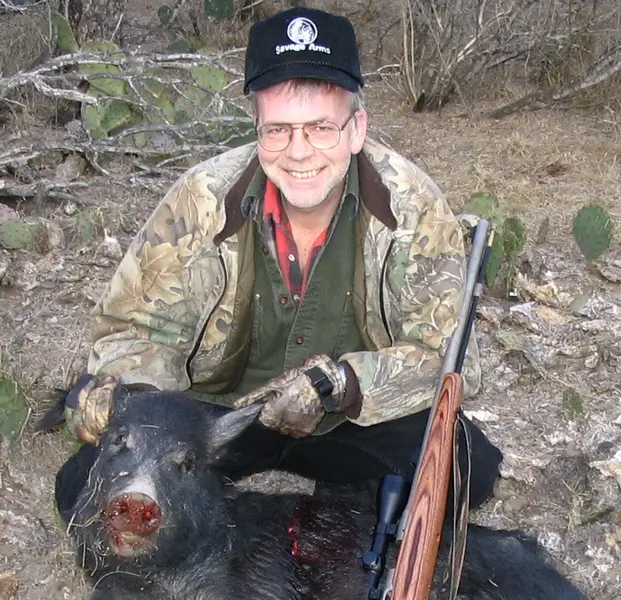
Everyone likes the term accuracy; it is universally applied to “accurate” barrels, “accurate” calibers, accurate stocks, accurate triggers, accurate propellants, accurate scopes, and accurate just about everything else. Yet, particularly, though all of these things may contribute, there are fundamentals that are more important, to hunters.
I.
IGNITION
What could be worse than a gun that doesn't go bang? Murphy's Law is more
right than wrong, but when Murphy kicks in, it is invariably at the worst
possible time. Reliability is more important than penultimate accuracy,
for when was the last time someone walked up to their buck and said, “If
that bullet hole was one half of one inch to the left, that deer would
REALLY be dead!” That would be a new event, at least for me. Contingent
on individual rifle, drilling out the breechplug and cleaning out the
front of the breechplug with torch tip cleaners may be necessary to ensure
proper ignition.
II. CLEAR YOUR GUN AT THE END OF EACH DAY
No propellant improves once it is loaded into a barrel, some are worse
than others, that's all. If you want to eliminate unwanted moisture absorption
and potential misfires or low velocities, discharge your gun at the end
of the day. It is also not as easy to double-charge a gun that isn't left
loaded, as too many have discovered.
III. WHAT ABOUT GROUP SIZE?
Of course group size and practicing at the ranges you intend to hunt at
makes good sense. However, it is only the first shot from a cold barrel
that matters. The “problem” with swabbing a barrel is that no
one would ever spit-patch a barrel for a follow-up shot on an animal.
A group size that relies on spit-patching or barrel swabbing is fine,
but that won't help when we are actually hunting. That's one of the many
reasons a propellant like Blackhorn 209 is a superior hunting propellant.
IV. WHAT ABOUT RECOIL?
There is nothing about recoil that can do anything but hurt accuracy.
While we claim to want lightweight rifles, increased recoil with the same,
heavy load is the invariable result. A heavy rifle is more fun to practice
with and more fun to shoot in general. The guns that aren't any fun to
shoot don't get practiced with: no surprise there. Some muzzleloaders
can kick just about as hard as you want them to, for we are the ones that
decide what to load into them.
V. WHAT ABOUT POWDER CHARGE?
Year after year in dozens of inlines, 110 grains by volume of loose powder
is right at the most accurate hunting charge, with Blackhorn 209 or Triple
Se7en FFg, pushing a 250 – 300 grain saboted bullet. Naturally, there
are exceptions, the reason we have to work up our own loads in our own
individual rifles, but that is a good generalization. Deer don't care
how fast you miss them.
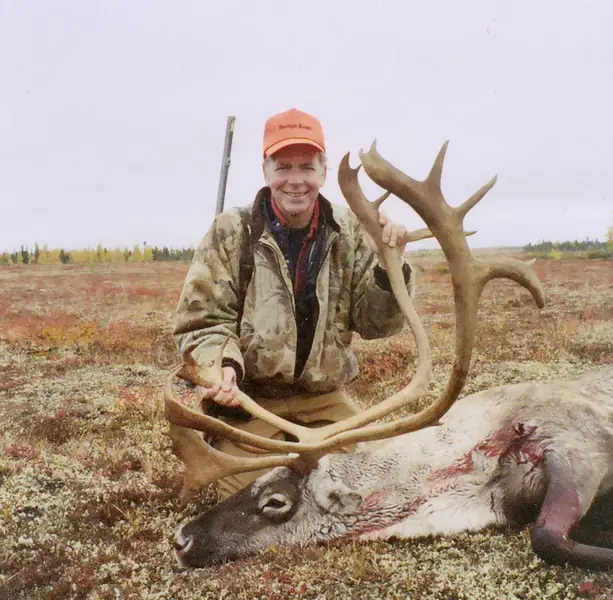
VI. HOW FAR CAN I SHOOT MY MUZZLELOADER?
As far as you wish: that's all up to you and your judgment. No one has
asked my how far they can shoot a .30-06. No one knows if you are standing
up, shooting off-hand, on your belly, or in a box blind in a tree, padded
all around, that is close to shooting off the bench as far as stability.
One of the classic attributes of an experienced hunter is knowing when
not to take the shot as much as knowing when to take the
shot.
As a practical matter, what is the difference between a doe and a spike
buck, at 200 yards, one half hour after sunset? A medium buck has a 10
inch kill zone, as long as you can place a single shot into it under your
personal hunting conditions, it is very quickly dead deer every single
time. Depredation work is a different matter, but that is hardly typical
hunting or hunting in any general sense at all.
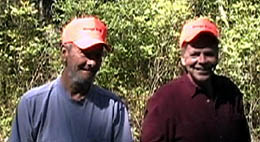
Consider what custom rifle-builder, gun designer, and multiple patent holder Henry Ball (inventor of what became the Savage 10ML) had to say.
No matter what you do with a relatively heavy, large caliber, low ballistic coefficient projectile, the trajectory degrades very quickly past 250 yards. This load is accurate, temperature insensitive, and lethal. Most shooters do not put in the practice time required for all the long range stuff you hear about, and cannot properly use wind management, which is far more likely to be ignored than vertical trajectory. Personally, my longest kill with a muzzleloader is at about 240 yards, and that is cracking about 4 inches of Kentucky windage above the animal’s back. That’s why I practice on groundhogs at 500 yards with my center fires. It makes taking a deer at that range a piece of cake.
Muzzleloaders, including mine, are short range weapons. The load described is absolutely devastating on deer out to past 325 yards. It is just that very, very few people will put in the substantial practice time to thoroughly learn their trajectory to ensure proper bullet placement at extended ranges. Learning your gun with a supremely accurate load with excellent terminal bullet performance is critical. Trying to move a large heavy bullet at super-high velocity in a muzzleloading application is no substitute, nor remotely as important as thoroughly learning your gun. Any unknowledgeable hunter can just try to burn more powder. A true marksman knows the capabilities of his hunting tool at all ranges before the trigger is ever pulled on a game animal, for he has done his homework and has the self-discipline to know when not to take a shot. After all, nobody “makes you” shoot at a deer.
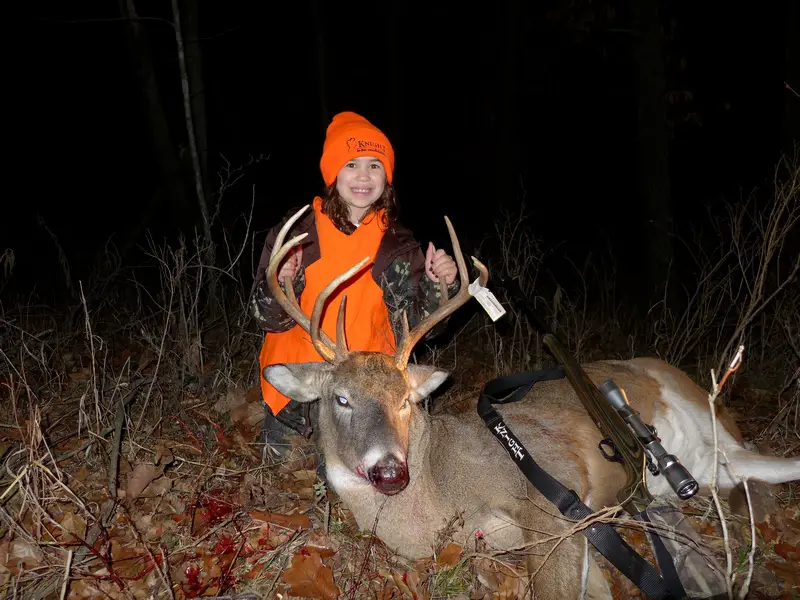
Above, Grace Knight, grandaughter of Tony Knight, then eight years old with her very first deer . . . guided by father Billy Knight. That was a memorable day, not just for Grace, for Grandpa Tony Knight and Grandma Rose Knight were thrilled as well. We all were. (Photo by Randy Wakeman)
VII.
TARGET MENTALITY VS. HUNTING MENTALITY
A target shooter often fires at non-moving, perfectly broadside pieces
of paper at known distances, from a steady rest, with no incline involved,
no significant changes in barometric pressure during the target shoot,
under brightly illuminated conditions. The bullseye is often one inch.
A hunter may be shooting off-hand, off of sticks, and rarely at a completely motionless animal, with no stream of air socks or wind flags set up down the hill. Game animals aren't always perfectly broadside and don't appear at predetermined, fixed ranges. The notion of a one inch target is nonsensical, for a large whitetail deer has a 10 inch kill zone. Group sizes to win a belt-buckle with or to brag about are completely off-topic, for only the first shot from a cold, fouled barrel is the one that really matters.
The goal is not a “group” at all, but one shot, a fast kill, and 100% game recovery. The skill of a hunter is not measured in tenths or quarters of an inch, but a combination of scouting, awareness, preparation, practice, and ability to approach, contingent on the hunt. Accuracy is still important, but only in terms of field accuracy, not mere accuracy worship to the exclusion of actually hunting. Experienced hunters know the difference between MOA holes in paper and "minute of whitetail."
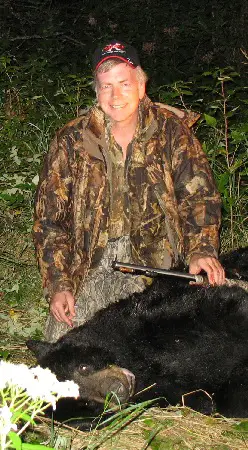
VIII. EXTERNAL BALLISTICS
A .452 250 grain Hornady XTP, fired at 2125 fps, has a 6 inch Point Blank
Range of 184 yards. With a 10 mph crosswind, wind drift is 37.23 inches
at 300 yards: terminal velocity at 300 yards is 1035 fps.
A .451 300 grain Parker Match Hunter, fired at 2125 fps, has a 6 inch Point Blank Range of 210 yards. With a 10 mph crosswind, wind drift is 11.31 inches at 300 yards: terminal velocity at 300 yards is 1564 fps. The value of a relatively high B.C. bullet shines at longer ranges, as in this example: right at 70% less wind drift . . . and over 50% higher impact velocity, at 300 yards.
Copyright 2014 by Randy Wakeman. All Rights Reserved.

Custom Search


